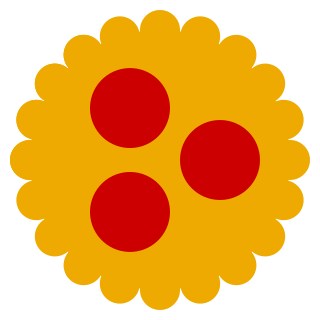
JPEG is a commonly used method of lossy compression for digital images, particularly for those images produced by digital photography. The degree of compression can be adjusted, allowing a selectable tradeoff between storage size and image quality. JPEG typically achieves 10:1 compression with little perceptible loss in image quality. Since its introduction in 1992, JPEG has been the most widely used image compression standard in the world, and the most widely used digital image format, with several billion JPEG images produced every day as of 2015.
Steganography is the practice of representing information within another message or physical object, in such a manner that the presence of the information is not evident to human inspection. In computing/electronic contexts, a computer file, message, image, or video is concealed within another file, message, image, or video. The word steganography comes from Greek steganographia, which combines the words steganós, meaning "covered or concealed", and -graphia meaning "writing".

Image compression is a type of data compression applied to digital images, to reduce their cost for storage or transmission. Algorithms may take advantage of visual perception and the statistical properties of image data to provide superior results compared with generic data compression methods which are used for other digital data.

JPEG 2000 (JP2) is an image compression standard and coding system. It was developed from 1997 to 2000 by a Joint Photographic Experts Group committee chaired by Touradj Ebrahimi, with the intention of superseding their original JPEG standard, which is based on a discrete cosine transform (DCT), with a newly designed, wavelet-based method. The standardized filename extension is .jp2 for ISO/IEC 15444-1 conforming files and .jpx for the extended part-2 specifications, published as ISO/IEC 15444-2. The registered MIME types are defined in RFC 3745. For ISO/IEC 15444-1 it is image/jp2.

A compression artifact is a noticeable distortion of media caused by the application of lossy compression. Lossy data compression involves discarding some of the media's data so that it becomes small enough to be stored within the desired disk space or transmitted (streamed) within the available bandwidth. If the compressor cannot store enough data in the compressed version, the result is a loss of quality, or introduction of artifacts. The compression algorithm may not be intelligent enough to discriminate between distortions of little subjective importance and those objectionable to the user.
Steganalysis is the study of detecting messages hidden using steganography; this is analogous to cryptanalysis applied to cryptography.

libjpeg is a free library with functions for handling the JPEG image data format. It implements a JPEG codec alongside various utilities for handling JPEG data. It is written in C and distributed as free software together with its source code under the terms of a custom permissive (BSD-like) free software license, which demands attribution. The original variant is maintained and published by the Independent JPEG Group (IJG). Meanwhile, there are several forks with additional features.
A digital watermark is a kind of marker covertly embedded in a noise-tolerant signal such as audio, video or image data. It is typically used to identify ownership of the copyright of such a signal. "Watermarking" is the process of hiding digital information in a carrier signal; the hidden information should, but does not need to, contain a relation to the carrier signal. Digital watermarks may be used to verify the authenticity or integrity of the carrier signal or to show the identity of its owners. It is prominently used for tracing copyright infringements and for banknote authentication.
Quantization, involved in image processing, is a lossy compression technique achieved by compressing a range of values to a single quantum (discrete) value. When the number of discrete symbols in a given stream is reduced, the stream becomes more compressible. For example, reducing the number of colors required to represent a digital image makes it possible to reduce its file size. Specific applications include DCT data quantization in JPEG and DWT data quantization in JPEG 2000.
Avid DNxHD is a lossy high-definition video post-production codec developed by Avid for multi-generation compositing with reduced storage and bandwidth requirements. It is an implementation of SMPTE VC-3 standard.
Steganographic file systems are a kind of file system first proposed by Ross Anderson, Roger Needham, and Adi Shamir. Their paper proposed two main methods of hiding data: in a series of fixed size files originally consisting of random bits on top of which 'vectors' could be superimposed in such a way as to allow levels of security to decrypt all lower levels but not even know of the existence of any higher levels, or an entire partition is filled with random bits and files hidden in it.
JPEG XR is an image compression standard for continuous tone photographic images, based on the HD Photo specifications that Microsoft originally developed and patented. It supports both lossy and lossless compression, and is the preferred image format for Ecma-388 Open XML Paper Specification documents.

PGF is a wavelet-based bitmapped image format that employs lossless and lossy data compression. PGF was created to improve upon and replace the JPEG format. It was developed at the same time as JPEG 2000 but with a focus on speed over compression ratio.

A steganography software tool allows a user to embed hidden data inside a carrier file, such as an image or video, and later extract that data.

OpenPuff Steganography and Watermarking, sometimes abbreviated OpenPuff or Puff, is a free steganography tool for Microsoft Windows created by Cosimo Oliboni and still maintained as independent software. The program is notable for being the first steganography tool that:
BPCS-steganography is a type of digital steganography.

Guetzli is a freely licensed JPEG encoder that Jyrki Alakuijala, Robert Obryk, and Zoltán Szabadka have developed in Google's Zürich research branch. The encoder seeks to produce significantly smaller files than prior encoders at equivalent quality, albeit at very low speed. It is named after the Swiss German diminutive expression for biscuits, in line with the names of other compression technology from Google.
JPEG XL is a royalty-free raster-graphics file format that supports both lossy and lossless compression. It is designed to outperform existing raster formats and thus become their universal replacement.
JPEG XS is an interoperable, visually lossless, low-latency and lightweight image and video coding system used in professional applications. Applications of the standard include streaming high-quality content for virtual reality, drones, autonomous vehicles using cameras, gaming, and broadcasting. It was the first ISO codec ever designed for this specific purpose. JPEG XS, built on core technology from both intoPIX and Fraunhofer IIS, is formally standardized as ISO/IEC 21122 by the Joint Photographic Experts Group with the first edition published in 2019. Although not official, the XS acronym was chosen to highlight the eXtra Small and eXtra Speed characteristics of the codec. Today, the JPEG committee is still actively working on further improvements to XS, with the second edition scheduled for publication and initial efforts being launched towards a third edition.






